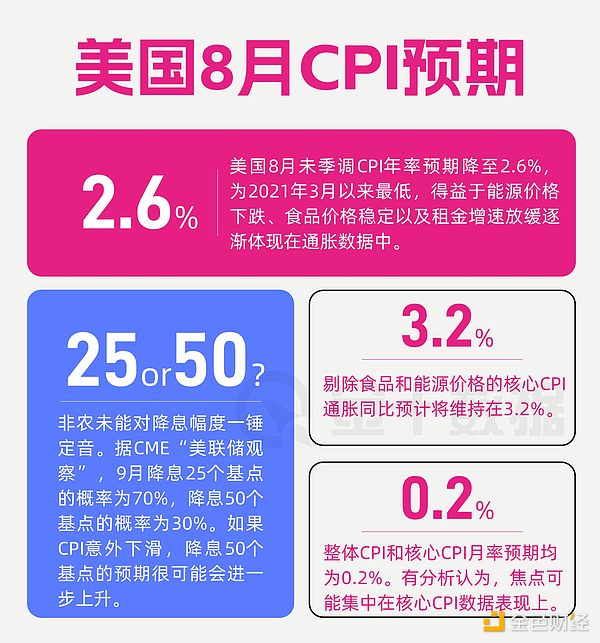The market is preparing for the first rate cut from the Federal Reserve. At the Jackson Hole conference, Fed Chairman Powell indirectly previewed the rate cut in the early hours of September 19 and emphasized the importance of the labor market in the current decision-making process. The mixed data on the job market released last week further confirmed the rate cut. However, the non-farm payrolls data last Friday also increased market concerns about the extent of the expected economic slowdown, leading to a negative reaction in most stock indexes.
Before the Fed entered its usual "quiet period", several Fed officials spoke on Friday, basically confirming the open secret of the rate cut and expressing support for the first and usually the most difficult rate cut decision in this round of interest rate cycle. However, most officials avoided publicly expressing support for a 50 basis point rate cut.
The focus of the market this week turned to inflation data, and the August CPI inflation report will be released at 8:30 pm Beijing time on Wednesday.Powell was very direct in his assessment of inflation at the Jackson Hole conference. He mentioned that inflation is now closer to the Fed's target and "upside risks to inflation have diminished." As a result, the importance of inflation data has declined, but the report still has significant market influence.
Interestingly, recent inflation-related information has been mixed. Last week's ISM services and the price component of the PMI delivered upside surprises, suggesting that inflation may be moving higher again. Similarly, the University of Michigan Consumer Sentiment Survey in mid-August showed that the 1-year expected inflation rate was 2.9%.
Economists expect the US headline CPI to slow to 2.6% year-on-year in August from 2.9% in July. Several economists said that lower gas prices and stable food prices could help control overall inflation. If the forecast holds, CPI inflation will be the lowest year-on-year since March 2021. Core CPI inflation, which excludes food and energy prices, is expected to fall to 3.2% year-on-year. These forecasts are in line with estimates from the Cleveland Fed's Nowcast model.

However, if we look at the performance of oil prices in 2023 and in August this year, we will find that the overall CPI is likely to fall this time. Oil prices rose 2.3% month-on-month in August 2023, but fell sharply by 7% in August this year. In other words, inflation may fall more sharply, providing more basis for more aggressive monetary policy decisions by doves within the Fed.
In addition, whether CPI inflation meets economists' expectations will largely depend on the speed of rent increases. Housing costs account for two-thirds of the CPI inflation index. Many economists expect that as slower rent increases gradually show up in official inflation data, rents will begin to put downward pressure on inflation. Notably, though, last month's data defied those expectations, showing rents continuing to unexpectedly rise.
Excluding housing, inflation has hovered around the Fed's target throughout the summer. The share of CPI components with price growth exceeding 3% is already below its pre-pandemic average, at just 25%. Gradually weakening U.S. economic growth, such as a decline in job openings indicating weak labor demand and a gradual rise in unemployment, has also bolstered confidence that broader inflationary pressures will continue to moderate. The economic collapse hasn't caused the Fed to panic, but it's becoming increasingly clear that interest rates are higher than the U.S. economy needs. ING economists said that since the non-farm payrolls data failed to convince the Fed to cut interest rates by 50 basis points, the market is now paying attention to US inflation data to understand the pace of the Fed's rate cuts. "It is clear that economic growth is losing momentum, and the market now seems to be concerned about whether the economy will eventually have a soft landing or a hard landing." According to CME's "Fed Watch", the probability of the Fed cutting interest rates by 25 basis points in September is 70%, and the probability of a 50 basis point cut is 30%. If inflation unexpectedly declines, expectations of a 50 basis point cut are likely to rise further. On the other hand, if the report results meet expectations, or even show a slight increase in inflationary pressure, although it will not change the market's expectations for the Fed's interest rate adjustment, it may to some extent suppress the dovish remarks that follow.
Charu Chanana, head of foreign exchange strategy at Saxo, said that a weaker-than-expected report may strengthen the market's expectations for a 50 basis point rate cut, but data that meet expectations may continue to leave the debate between a 25 basis point and a 50 basis point rate cut unresolved. "Overall, the dollar is expected to move sideways higher, as the Fed's current easing expectations still appear excessive."
Federal Reserve policymakers said last week that they were ready to start a series of rate cuts, noting that the cooling of the labor market could become more terrifying if no policy shift was made. Chanana therefore believes: "This makes the Fed likely to choose a 25 basis point rate cut to avoid causing panic, although they may take more aggressive rate cuts later this year."
Other analysts believe that the focus may still be on the core CPI data, the decline in the data has stagnated for some time. If price volatility is low but progress is lacking, the risk-positive momentum could falter a bit this week as traders may decide the data is not strong enough to convince the Fed to cut rates by 50 basis points next week.
 Hui Xin
Hui Xin







